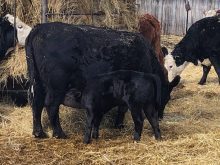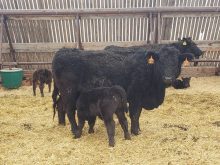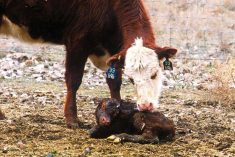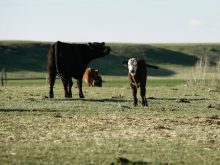Transportation is an important and inevitable component of marketing cattle through different sectors of the beef industry, but how does that trucking experience affect the health and well being of livestock?
Dr. Karen Schwartzkopf-Genswein, principal research scientist with Agriculture and Agri-Food Canada’s Lethbridge Research Station, says whether it’s calves or backgrounders moving to feedlots for finishing or to the packing plant, selling typically means travel. “It’s all part of the production continuum.”
On average, cattle are transported anywhere from three to seven times during their lifetime, with each event displaying distinct consequences for various types of animals. Using her experience studying transportation, Schwartzkopf-Genswein has attempted to separate exactly which aspects leading up to and during transportation cause health and welfare issues, and which do not.
Read Also

Harvest wraps up and fall work begins
At the Eppich famly ranch in western Saskatchewan, the fall harvest was successful with few breakdowns, cows and calves have been sorted and a new tractor has arrived
Calf challenges
“We began with several simple questions,” says Schwartzkopf-Genswein. “Is it the distance travelled or the time on a truck without feed, water or rest? Is it loading density, environmental circumstances or the animal’s condition? Are the calves in good health, or are problems associated with offloading and reloading during mandated rest stops? How were they managed prior to being loaded?”
As a starting point, it’s accepted and documented there is a relationship between transportation and stress, especially for calves.
Newly weaned calves are bombarded with life-changing events such as being separated from their mother and the accompanied change from a milk to a forage (and some grain) diet. They may also be ear-tagged, vaccinated, dehorned or castrated, with these stressful events often occurring together before they’re moved off the ranch.
“Transport represents yet another stress in the form of fear, and also energy demands required for loading and maintaining balance and body temperature,” Schwartzkopf-Genswein says. “Very young calves don’t thermoregulate like older animals as they can’t dissipate heat well or have the fat reserves to counteract the cold.”
Stress reduces immunity and the ability of the body to naturally fight off infections. This makes calves more susceptible to respiratory diseases such as BRD.
“We lump these factors together as ‘shipping fever’ which is somewhat misleading, as it implies shipping is the sole cause of the stress that potentially makes them sick,” says Schwartzkopf-Genswein. “All these factors happen at once; the transport is the cherry on top.”
To address these matters, the Canadian Food Inspection Agency (CFIA) has updated its transport regulations, dropping the travel time from 48 to 36 hours before a rest stop is required for weaned calves. Mandatory rest periods increased from five to eight hours.
Testing both rest and road
To analyze the science behind these regulations, Schwartzkopf-Genswein and her team, including Dr. Daniela Meléndez Suárez, completed trials aimed at studying transport effects on behaviour, vigour, performance, fatigue, and health and well-being.
Initially, 320 weaned Angus-cross seven- to eight-month-old ranch-purchased calves were hauled either 12 or 36 hours before being assigned variable rest periods ranging from zero, four, eight to 12 hours. With a previous eight hours of travel from the ranch of origin, vaccinations and other typical induction procedures plus an acclimation period of 18 to 26 days was provided to ensure this earlier stress wouldn’t factor into results. This wasn’t a true preconditioning program, but that 18- to 26-day rest period before being shipped ended up playing an important role in this study.
The team was surprised to discover the changing rest periods during transportation appeared to have little effect on the calves.
“We realized we didn’t see differences in the first study because we ‘conditioned’ them,” says Schwartzkopf-Genswein. “The shorter 18-26-day on-farm period didn’t meet the formal definition of ‘preconditioning,’ but we believed by weaning, vaccinating, and accustoming them to new pens and feed for those 18 to 26 days before we started our trial meant a rest during transportation didn’t improve their overall health, performance or well-being up to 28 days after arrival at the feedlot.”
Subsequent trials tested ‘conditioned’ versus ‘unconditioned’ calves plus auction-purchased versus ranch-direct calves. Even with variable rest stop durations and calf sources, few consequences were noticed with all groups. The largest indicators were observed between conditioned and unconditioned animals.
A concluding trial added four- to 15-hour travel times after the final rest period to determine if longer times changed the influence of the rest. Again, rest times or length of travel after these periods had little impact. Based on these consistent findings across numerous trials using the same indicators, the team was confident the largest factor in how well calves manage transport depends on whether they’re conditioned before being transported.
Research found preconditioning is beneficial for feed calves, and improves their ability to handle transport stress more than providing feed, water and rest during the trip. “The condition of the animal going onto the truck really dictates how well they manage the transport. The studies show how important preconditioning is — it really makes a difference,” she says.
“Transport concerns are fine, but we need to make sure regulations work under real conditions rather than us simply appearing to do the right thing. Our practices must reflect what the animals are telling us.”















